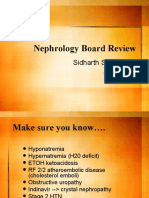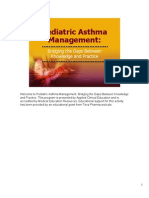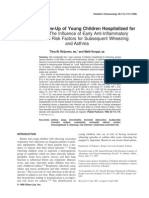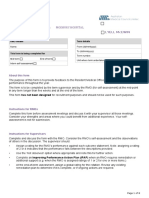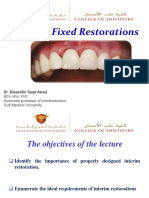A&e Case Summary
A&e Case Summary
Uploaded by
YOS HANACopyright:
Available Formats
A&e Case Summary
A&e Case Summary
Uploaded by
YOS HANAOriginal Title
Copyright
Available Formats
Share this document
Did you find this document useful?
Is this content inappropriate?
Copyright:
Available Formats
A&e Case Summary
A&e Case Summary
Uploaded by
YOS HANACopyright:
Available Formats
Student name: Yoshana Muruganand Patient’s R/N: HTJ1024621
Student ID: 00000026024 Date of admission: 12/1/2021
Patient’s initials: ARA Date of clerking: 12/1/2021
ARA ,4 years old Malay boy was brough to the emergency department due to rapid breathing which started at night.
The boy had cough and runny nose for 3 days with greenish sputum production. He also had fever for a day with 2
episodes of vomiting. His mom told that his oral intake has been reduced and he became less active. He started going
to school since a week ago. His mom denied any episodes of diarrhea and any Covid-19 or sick contact. His
immunization is up to age and this is his 3rd hospitalization. His 1st admission was at birth for jaundice and his 2 nd
admission was at 2 years old for Viral gastroenteritis. He has no history of eczema. He is sensitive to cold
environment which causes runny nose.
He was alert, conscious and tachypneic at the time of admission. His peripheries were warm with good pulse volume.
Capillary refill was within 2 sec. Vital signs: pulse rate: 157 beats/minute; respiratory rate: 37 breaths/minute; Spo2:
94-95% at the time of admission. There was no enlarged tonsil during throat examination. During auscultation of the
lungs, there was generalized rhonchi and crepitation was heard over the left lower zone of his lung. Air entry was tight
bilaterally. Cardiovascular examination revealed dual rhythm and no murmur. His abdomen was soft and non-tender.
Provisional diagnosis- Asthma
Differential diagnosis- Viral Pneumonia, Asthma, Influenza
Investigation- Chest Xray- hyperinflated lungs and haziness over the right side
Final diagnosis- Preschool wheeze with multi triggers
Management- MDI Salbutamol 6 puffs burst, waiting for admission.
Learning issue:
1) Critical thinking, problem solving and research: Preschool Wheeze Vs Asthma?
The pathology and natural progression of wheezing illnesses in pre-school children is variable and not fully
understood. The term asthma is not used to describe a wheezing illness in pre-schoolers as there is insufficient
evidence that the pathophysiology is similar to that of asthma in older children and adults. The type of wheeze a child
experiences can change over time. Pre-schoolers commonly experience wheeze during discrete time periods, often in
association with clinical evidence of a viral infection (such as rhinovirus, RSV, coronavirus, human metapneumovirus,
parainfluenza virus and adenovirus) with symptoms absent between episodes. Repeated episodes tend to occur
seasonally, and it usually declines over time disappearing by six years of age. This is known as an episodic viral
wheeze. Less commonly, a pre-school child can experience a multi-trigger wheeze. In such cases symptoms also occur
between acute exacerbations. Viral infection is a common trigger, but other triggers include tobacco smoke, allergen
exposure, mist, crying, laughter and exercise. Risk factors for a future diagnosis of asthma include: 1) onset of wheeze
over the age of 18 months, 2) personal history of atopy e.g. eczema, 3) maternal asthma. Several clinical predictive
indices for future risk of asthma have been developed based on combinations of the presence of atopic manifestations,
indirect evidence of airway inflammation such as peripheral blood eosinophil count, and severity of pre-school
wheeze.2 The ability of these tools to identify those who will develop asthma is poor (positive predictive value (PPV)
ranging from 44 to 54%). However, the absence of known risk factors can be useful to reassure parents of a lower risk
of future asthma.
2) Clinical Skills: Assessment in Preschool wheeze patient?
The purpose of assessment (history taking and physical examination) is to: • confirm a wheezing disorder • identify
symptom pattern, severity and possible trigger factors • look for features suggestive of an alternative diagnosis or
associated condition. Studies have shown while physicians can accurately identify wheeze, parents may not be able to
do so. Ideally, the presence of a wheeze should be confirmed by a clinician.
History should include specific information on: • the wheeze, other noises and features of respiratory distress • family
history (including mother and sibling/s) of asthma and atopy • smoking status of household members.
All health professionals have a role in advocating for their patients by advising parents about the increased risk of
wheezing associated with parental smoking.
The child should be assessed within the time frame recommended by the triage category. General appearance, mental
state and level of respiratory distress are the most important markers of illness severity. Signs of respiratory distress in
pre-school children include accessory muscle use, abdominal breathing, intercostal recession, subcoastal recession and
tracheal tug.
You might also like
- Case Study PneumoniaDocument45 pagesCase Study PneumoniaYashoda Satpute89% (9)
- Asthma - Case PresentationDocument56 pagesAsthma - Case Presentationsarooah199471% (7)
- Statistics NotesDocument94 pagesStatistics NotesHansraj Singh100% (1)
- 6.19.07 Nephrology Board Review ShahDocument57 pages6.19.07 Nephrology Board Review Shahactidwell50% (2)
- Pneumonia Case Pres Level 2 Group 4Document43 pagesPneumonia Case Pres Level 2 Group 4Archie Punzalan67% (3)
- PnuemoniaDocument102 pagesPnuemoniaRegineCuasSulibNo ratings yet
- Case PresentationDocument18 pagesCase PresentationNoli Galope IINo ratings yet
- Risk Factors of Recurrence of Febrile Seizures in Children in A Tertiary Care Hospital in Kanpur - A One Year Follow Up StudyDocument7 pagesRisk Factors of Recurrence of Febrile Seizures in Children in A Tertiary Care Hospital in Kanpur - A One Year Follow Up StudyFarra PattipawaeNo ratings yet
- presentationonpneumonia-170213100824Document38 pagespresentationonpneumonia-170213100824anvaraadhil78No ratings yet
- Pediatric Asthma ManagementDocument81 pagesPediatric Asthma Managementmartinbsas100% (9)
- Clinical Case Logs ReportDocument14 pagesClinical Case Logs ReportSeth Therizwhiz RockerfellaNo ratings yet
- Assessing and Managing Wheezing in Preschool ChildrenDocument8 pagesAssessing and Managing Wheezing in Preschool ChildrenEndy Widya PutrantoNo ratings yet
- Acute Bronchitis... The OneDocument35 pagesAcute Bronchitis... The One'mYk FavilaNo ratings yet
- Upper Respiratory Tract InfectionDocument26 pagesUpper Respiratory Tract InfectionKylie Golindang67% (3)
- Case Study - PneumoniaDocument41 pagesCase Study - PneumoniaCaleb Mcmahon67% (6)
- Care of Pediatric Patients During COVID-19 Pandemic-04042020Document60 pagesCare of Pediatric Patients During COVID-19 Pandemic-04042020Florin StanciuNo ratings yet
- Tosse Cronica em CriançasDocument17 pagesTosse Cronica em CriançasEdvaldo Pereira da Silva JúniorNo ratings yet
- Bronchiolitis ScriptDocument6 pagesBronchiolitis ScriptAhmed RmelahNo ratings yet
- Acute Cough in Children: Diagnosing Aris SeriesDocument4 pagesAcute Cough in Children: Diagnosing Aris SeriesCzarina Isabela TuazonNo ratings yet
- 12701-50629-1-PB-1 AnakDocument4 pages12701-50629-1-PB-1 AnakAni RoseNo ratings yet
- Case Presentation Calalang General Hospital: Far Eastern University Institute of Nursing Summer 2009Document15 pagesCase Presentation Calalang General Hospital: Far Eastern University Institute of Nursing Summer 2009Bianca de GuzmanNo ratings yet
- Broncho PneumoniaDocument14 pagesBroncho Pneumoniadanee しNo ratings yet
- Case Presentation Calalang General Hospital: Far Eastern University Institute of Nursing Summer 2009Document13 pagesCase Presentation Calalang General Hospital: Far Eastern University Institute of Nursing Summer 2009Bianca de GuzmanNo ratings yet
- Case - Presentation PneumoDocument5 pagesCase - Presentation PneumoMer CyNo ratings yet
- Case Study MCHDocument9 pagesCase Study MCHShazwan FarhanNo ratings yet
- Case StudyDocument111 pagesCase StudyBrian OballoNo ratings yet
- Infectious Diseases CasesDocument30 pagesInfectious Diseases Casestaliya. shvetzNo ratings yet
- Jurnal AsmaDocument11 pagesJurnal AsmaAi Siti Rika FauziahNo ratings yet
- C C C ! "##$%& ' $#+ ,-C " % .# .# " / 1 !% ! 23 "% 23 ! C % !Document4 pagesC C C ! "##$%& ' $#+ ,-C " % .# .# " / 1 !% ! 23 "% 23 ! C % !ejkohNo ratings yet
- Wheezy InfantDocument3 pagesWheezy InfantAzizan HannyNo ratings yet
- Research About:: by Group 6Document11 pagesResearch About:: by Group 6hgkjhjhNo ratings yet
- Pediatric Emergency and Critical CareDocument612 pagesPediatric Emergency and Critical Careabdul qayyunNo ratings yet
- Asthma Case Report FinalDocument6 pagesAsthma Case Report FinalJiaYee Go0% (1)
- N32 AH1N1 (Argate Muana)Document17 pagesN32 AH1N1 (Argate Muana)CHRISTIAN RAY ALPAS PASILIAONo ratings yet
- Community-Acquired Pneumonia in Infants and ChildrenDocument9 pagesCommunity-Acquired Pneumonia in Infants and ChildrenLorenn AdarnaNo ratings yet
- MainDocument6 pagesMainDiana Catalina Avila BareñoNo ratings yet
- Consenso Chileno Sochinep-Ser para El Diagnostico y Tratamiento Del Asma en El EscolarDocument21 pagesConsenso Chileno Sochinep-Ser para El Diagnostico y Tratamiento Del Asma en El EscolarCONSTANZA VICTORIA QUIJADANo ratings yet
- SURIGAO EDUCATION CENTER PcapcDocument9 pagesSURIGAO EDUCATION CENTER PcapckholeensendrienesheensNo ratings yet
- Case Study-Tb MeningitisDocument41 pagesCase Study-Tb Meningitislhan alvin83% (6)
- The New England Journal of Medicine: MethodsDocument9 pagesThe New England Journal of Medicine: MethodsannisaoktovianiNo ratings yet
- Wheezing in ChildrenDocument7 pagesWheezing in ChildrenAzmachamberAzmacareNo ratings yet
- Pleural EffusionDocument38 pagesPleural EffusionMela VincoNo ratings yet
- Febrile Seizure Case FileDocument4 pagesFebrile Seizure Case Filehttps://medical-phd.blogspot.comNo ratings yet
- Recurrent Wheeze in Pre-School Children: Respiratory MedicineDocument5 pagesRecurrent Wheeze in Pre-School Children: Respiratory MedicinejprakashjjNo ratings yet
- Case 3 DengueDocument19 pagesCase 3 DengueJane LaquihonNo ratings yet
- Case 3 DengueDocument19 pagesCase 3 DengueJane LaquihonNo ratings yet
- University of Northern Philipiens: Republic of The Philippines Tamag, Vigan City 2700, Ilocos SurDocument25 pagesUniversity of Northern Philipiens: Republic of The Philippines Tamag, Vigan City 2700, Ilocos SurRence Bernard Arde TicaNo ratings yet
- READINGS PcapDocument2 pagesREADINGS PcapEden RelacionNo ratings yet
- Pertussis Whooping Cough Is BackDocument17 pagesPertussis Whooping Cough Is BackBahaa Ahmad AssoudNo ratings yet
- Trinity University of Asia St. Luke'S College of Nursing Case Study (Opd) NAME: Marie Deborah Kay B. Chakas CASE: Pneumonia (Pedia)Document19 pagesTrinity University of Asia St. Luke'S College of Nursing Case Study (Opd) NAME: Marie Deborah Kay B. Chakas CASE: Pneumonia (Pedia)MARIE DEBORAH KAY CHAKASNo ratings yet
- 2.5. Flu-Like IllnessDocument24 pages2.5. Flu-Like IllnessM HNo ratings yet
- Asthma ManagementDocument19 pagesAsthma Managementdrpragya82No ratings yet
- Rinitis AlergicaDocument6 pagesRinitis Alergicaismael_132No ratings yet
- Infectious Pediatric Pneumonia: Author: Roberta D. Hood, HBSC, MD, CCFP Date Created: December 2011Document137 pagesInfectious Pediatric Pneumonia: Author: Roberta D. Hood, HBSC, MD, CCFP Date Created: December 2011Kartika Rezky100% (1)
- A Cough or Difficulty and Fast Breathing in Your Child Should Ensure Visitation To The DoctorDocument3 pagesA Cough or Difficulty and Fast Breathing in Your Child Should Ensure Visitation To The DoctorGideon MurathaNo ratings yet
- Prognostic Value of TH1/TH2 Cytokines in Infants With Wheezing in A Three Year Follow-Up StudyDocument6 pagesPrognostic Value of TH1/TH2 Cytokines in Infants With Wheezing in A Three Year Follow-Up StudyLinda JajauuooNo ratings yet
- Chapter I VaricellaDocument5 pagesChapter I VaricellaKismet SummonsNo ratings yet
- Case PresentationDocument89 pagesCase PresentationBakerbrown CrumbsworthNo ratings yet
- Clinical Management Protocol PDFDocument7 pagesClinical Management Protocol PDFAJEET KUMAR PANDEYNo ratings yet
- Food Protein Induced Enterocolitis (FPIES): Diagnosis and ManagementFrom EverandFood Protein Induced Enterocolitis (FPIES): Diagnosis and ManagementTerri Faye Brown-WhitehornNo ratings yet
- Diagnosis and Treatment of Chronic CoughFrom EverandDiagnosis and Treatment of Chronic CoughSang Heon ChoNo ratings yet
- Unit 3 PharmacovigilanceDocument16 pagesUnit 3 Pharmacovigilancerakesh meherNo ratings yet
- Waste Segregation Data Sheet-August - 2019 RE2Document3 pagesWaste Segregation Data Sheet-August - 2019 RE2emidNo ratings yet
- Care of Patients With Mechanical VentilatorDocument4 pagesCare of Patients With Mechanical VentilatorIman Bee Sanayon0% (1)
- Copd ImDocument28 pagesCopd ImBianca Watanabe - RatillaNo ratings yet
- L27 - PSC Malad Hop 8, GRD FLR, Kiran Towers Co-Op HSG Society Limited, Rajanpada, Pannalal MumbaiDocument11 pagesL27 - PSC Malad Hop 8, GRD FLR, Kiran Towers Co-Op HSG Society Limited, Rajanpada, Pannalal MumbaiAkanksha GharatNo ratings yet
- GE MergedDocument140 pagesGE MergedDaksh JethwaNo ratings yet
- Targeted Patient Safety QuestionnairesDocument27 pagesTargeted Patient Safety QuestionnairesAafreen KhairNo ratings yet
- Alcohol and Other Drugs by Sai KiranDocument1 pageAlcohol and Other Drugs by Sai KiranmurthygrsNo ratings yet
- Cardiovascular Research Convergence 2022Document16 pagesCardiovascular Research Convergence 2022Aditya SutarNo ratings yet
- Visión Critica ColecistectomiaDocument6 pagesVisión Critica ColecistectomiaEduardo Lopez100% (1)
- Laporan Pasien Rawat Inap Divisi Endokrin FauzanDocument11 pagesLaporan Pasien Rawat Inap Divisi Endokrin Fauzanfauzan azhariNo ratings yet
- RMO Assessment Form 2016Document8 pagesRMO Assessment Form 2016Tp HoangNo ratings yet
- Immuno SeroDocument102 pagesImmuno SeroCaressa Marie EstradaNo ratings yet
- Medi Assist Policy Conditions 2018-19Document22 pagesMedi Assist Policy Conditions 2018-19saran2rasuNo ratings yet
- ISO 21872 - 1 - 2017-VibrioDocument40 pagesISO 21872 - 1 - 2017-VibrioQA & QC. HOAN VU LABORATORYNo ratings yet
- Histopathological Study of Bronchopneumonia Types of Pulmo in Slaughtered Pig of Oeba SlaughterhouseDocument11 pagesHistopathological Study of Bronchopneumonia Types of Pulmo in Slaughtered Pig of Oeba SlaughterhouseNovrianto AlbertinoNo ratings yet
- CEP Health SectorDocument94 pagesCEP Health SectorJamila KapasiNo ratings yet
- Hospital Thesis PDFDocument6 pagesHospital Thesis PDFerinriverachicago100% (3)
- In-depth virological and immunological characterization of HIV-1 cure after CCR5Δ32/Δ32 allogeneic hematopoietic stem cell transplantationDocument23 pagesIn-depth virological and immunological characterization of HIV-1 cure after CCR5Δ32/Δ32 allogeneic hematopoietic stem cell transplantationJorge AndrésNo ratings yet
- Air Pollution: Mechanisms of Neuroinflammation and CNS DiseaseDocument11 pagesAir Pollution: Mechanisms of Neuroinflammation and CNS DiseaseChintrai ThavonlunNo ratings yet
- Baygon MSDSDocument9 pagesBaygon MSDSRobert FlorezNo ratings yet
- 5.lembar Observasi Fase LatenDocument2 pages5.lembar Observasi Fase LatenKia Pkm sukowonoNo ratings yet
- Chapter 1Document7 pagesChapter 1pedailynNo ratings yet
- Boosting ART Uptake and Retention Among HIV Infected Women and Their InfantsDocument4 pagesBoosting ART Uptake and Retention Among HIV Infected Women and Their InfantsDouglas ChukwuNo ratings yet
- L5 - Interim Fixed Restorations 1Document35 pagesL5 - Interim Fixed Restorations 1ALAA IBRAHIM IBRAHIMNo ratings yet
- Speech Outline - Mental IllnessDocument5 pagesSpeech Outline - Mental Illnessnaurahiman100% (1)
- Cureall Framework Who Global Initiative For Childhood Cancer PamphletDocument9 pagesCureall Framework Who Global Initiative For Childhood Cancer PamphletLuz RamNo ratings yet
- Lec 21Document28 pagesLec 21Ukash sukarmanNo ratings yet



